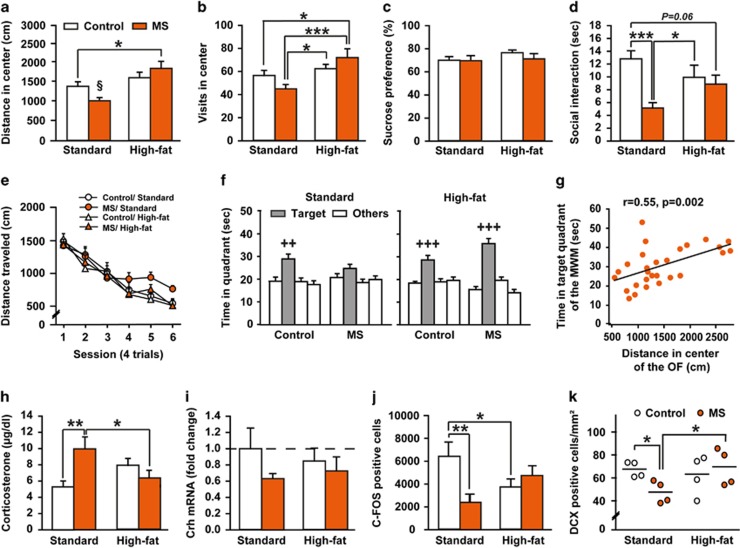Figure 3.
Maternal high-fat diet alleviates offspring endophenotypes induced by maternal separation. (a) Distance traveled (cm) and (b) number of visits in the center of the open field (n=15 for SD-control and HFD–control, n=14 for SD–MS and HFD–MS). (c) Sucrose preference (percentage of sucrose solution consumption relative to total fluid intake) over 24 h (n=15 for SD–control and HFD–control, n=14 for SD–MS and HFD–MS). (d) Time (sec) spent in social interaction (n=7 per group). (e) Distance traveled (cm) to reach the hidden platform during learning and (f) time (sec) spent in the target quadrant during the probe test, 48 h after the last training session (n=15 for SD–control and HFD–control, n=14 for SD–MS and HFD–MS). (g) Significant positive correlation between distance traveled in the center of the open field and time spent in target quadrant in the water maze in adult offspring exposed to MS (n=28). (h) Plasma corticosterone levels (μg dl−1) (n=15 for SD–control and HFD–control, n=14 for SD–MS and HFD–MS), (i) Crh mRNA expression in the hypothalamus (fold change) (n=6 for SD–control, SD–MS and HFD–MS; n=7 for HFD–control) and (j) Number of C-FOS-IR cells in the PVN 1 h after 10 min open-field exposure (n=8 for SD–control, SD–MS and HFD–control; n=7 for HFD–MS). (k) Number of DCX-IR cells in the DG of the hippocampus (cells per mm2; n=4 per group). Crh, Corticotropin-releasing hormone; DCX, Doublecortin; HFD, high-fat diet; MS, maternal separation; SD, standard diet. *P<0.05, **P<0.01 and ***P<0.001; §P=0.07 compared with SD–control and P<0.05 compared with HFD–control and HFD–MS; ++ at least P<0.01 and +++ at least P<0.001 compared with all other quadrants.

